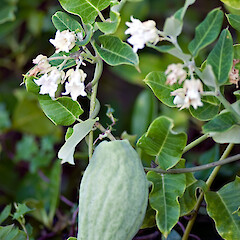Araujia hortorum
Common name
moth plant, moth vine
Synonyms
Araujia sericifera sensu NZ botanists
Family
Asclepiadaceae
Flora category
Vascular – Exotic
Structural class
Lianes & Related Trailing Plants - Dicotyledons
NVS code
The National Vegetation Survey (NVS) Databank is a physical archive and electronic databank containing records of over 94,000 vegetation survey plots - including data from over 19,000 permanent plots. NVS maintains a standard set of species code abbreviations that correspond to standard scientific plant names from the Ngä Tipu o Aotearoa - New Zealand Plants database.
ARASER
Conservation status
Not applicable
Habitat
Terrestrial. coastal, lowland cliff, bluff, waste places and other modified habitats (Timmins & MacKenzie 1995).
Detailed description
Rampant, evergreen vine to 10 m tall with smelly, milky sap. Stems twining, flexible, tough, downy, woody near base. Leaves opposite, 3-12 x 2-6 cm, dark green, hairless and dull above, greyish-downy below. Flowers bell-shaped, 20-25 mm diam, white, occ with pale pink streaks, usually in 2-4 clusters, Dec-May (can trap and kill insects). Distinctive pear-shaped choko-like pod, 10 x 7 cm, thick and leathery, containing kapok-like pulp, splits open dispersing many black, thistle down-like seeds.
Similar taxa
The sticky sap is useful when identifying seedlings and tuberous roots. When fruiting the large seed pods are unmistakable.
Flowering
December, January, February, March, April, May
Flower colours
White
Fruiting
Autumn and winter (ARC, 1998).
Life cycle
Perennial. Seeds are viable for at least 5 years (Timmins & MacKenzie 1995). Freely sets seed, 400 per follicle; dispersed by wind (ibid.).
Year naturalised
1888
Origin
S Brazil, Argentina
Reason for introduction
Ornamental
Etymology
araujia: Named after 19th century Portugese statesman and plant collector, Antonio de Matos Araujo.
National Pest Plant Accord species
This plant is listed in the 2020 National Pest Plant Accord. The National Pest Plant Accord (NPPA) is an agreement to prevent the sale and/or distribution of specified pest plants where either formal or casual horticultural trade is the most significant way of spreading the plant in New Zealand. For up to date information and an electronic copy of the 2020 Pest Plant Accord manual (including plant information and images) visit the MPI website.
Poisonous plant
The white latex substance in all parts of this plant is poisonous.



















